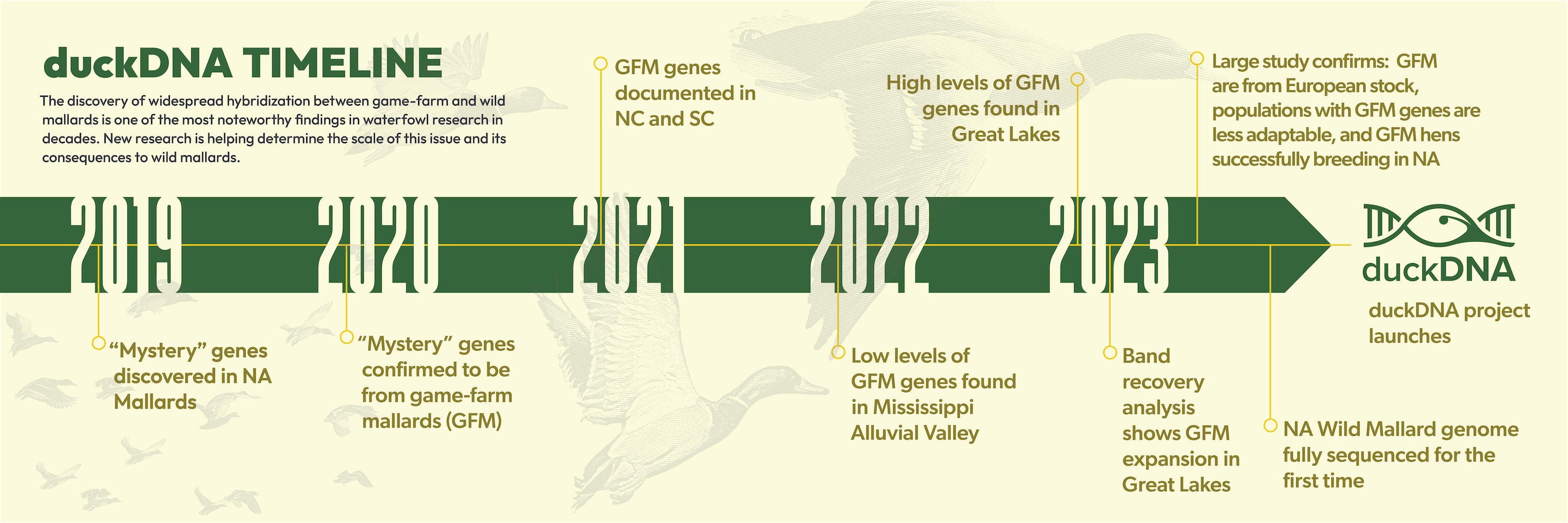In the Atlantic flyway, releases of game-farm Mallards—a domestic breed of Mallard—have been occurring for over 100 years. During that time, tens of millions of domestic birds have been released under the assumption that they would not survive in the wild.
Recent work by waterfowl geneticist Dr. Phil Lavretsky at the University of Texas at El Paso has shown this is not the case. Rather than dying off as assumed, game-farm Mallards are interbreeding with wild Mallards.
Typically, hybrid offspring (game-farm × wild Mallard) will mate with fully wild Mallards, which over time will produce essentially wild offspring through the dilution of game-farm genes. However, the scale of game-farm releases in some regions of North America has dramatically diluted the wild gene pool. In fact, most Mallard populations of the Atlantic flyway and the Great Lakes are now scientifically characterized as game-farm × wild Mallard hybrid swarms.

So why care about this issue? Game-farm Mallards, like any domesticated breed, are genetically and biologically different from their wild counterparts. In fact, game-farm Mallards are ten times more different than an American Black Duck is from a Mallard! In short, these hybrids look like Mallards, but their relationship to wild Mallards is akin to your Labrador Retriever's relationship to a wolf!
From migration behavior to bill shape and their capacity to feed, game-farm hybrids look like a Mallard and quack like a Mallard, but they are not the truly wild Mallards we’ve come to love.
This issue is not isolated to the Atlantic flyway. Recent data has shown that the hybrid swarm is spreading west, leading researchers to believe it is now of national and international concern. The introduction of domestic traits into wild populations can have adverse effects on hybridized individuals.
If the hybrid swarm continues, the negative traits could be amplified on the landscape, irreversibly changing the North American Mallard as we know it. That’s where you, the hunter, can assist!
To better understand this emerging issue, researchers like Dr. Lavretsky need genetic data on Mallards and Mallard-like ducks from across the U.S. Hunters have contributed valuable data to waterfowl managers for over a half-century through band reports and harvest surveys. Now, waterfowl hunters can enter a new frontier of community science!
By providing tissue samples for genetic analysis, you will become a modern-day “hunter-scientist.” You will help waterfowl researchers and managers expand their understanding of this issue and inform strategies to ensure the wild Mallard duck is around for future generations.
You can learn more about this critical issue and the research conducted by Dr. Lavretsky and his students and partners here.
Thanks to your overwhelming support, our 2024-25 season was an incredible success. At this time, our application portal is closed, but we anticipate reopening by August. Stay informed of the latest updates and future opportunities by providing your email address and following us on Instagram and Facebook.
Ducks Unlimited uses cookies to enhance your browsing experience, optimize site functionality, analyze traffic, and deliver personalized advertising through third parties. By continuing to use this site, you agree to our use of cookies. View Privacy Policy